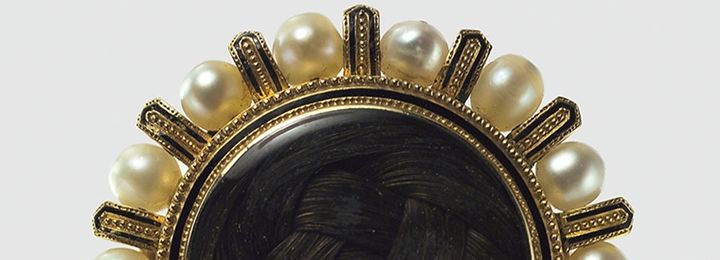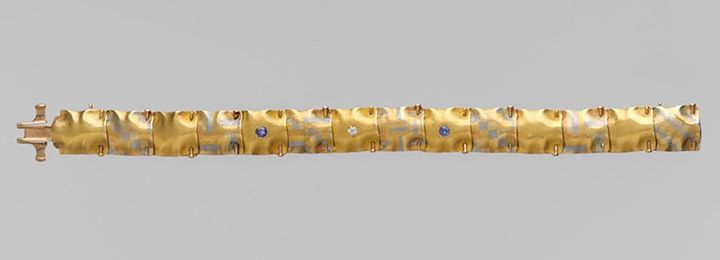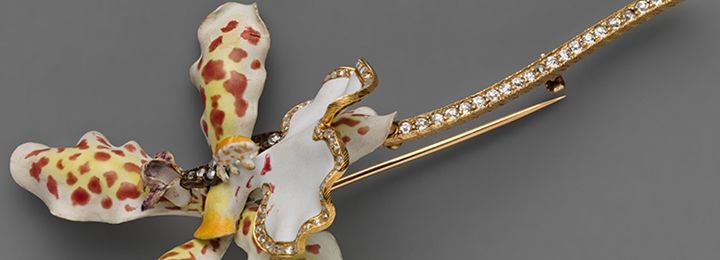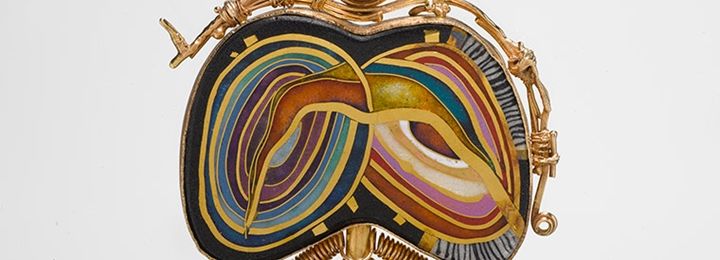Jewelry has been worn for millennia to adorn, empower, and protect its wearers. This installation, drawn entirely from The Met collection, chronicles the evolution of jewelry owned and made by Americans from the early eighteenth century to the present day. American jewelry was first acquired by the Museum in 1883, and it was the focus of a small exhibition by the spring of 1926. Since then, through generous gifts and judicious purchases, the Museum's holdings have grown to encompass a wide array of American adornments.
Organized in five broadly chronological sections, this presentation begins with small sentimental objects, such as treasured family heirlooms transported by immigrants to colonial America. Later, Americans imported pieces from abroad or turned to local goldsmiths. By the early nineteenth century, against a backdrop of financial prosperity and technological progress, entrepreneurs established a national industry that would become a major producer of fine and artistic jewelry.
The exhibition reveals significant changes in styles, materials, and techniques that occurred over the course of three centuries, including the early use of hair to memorialize loved ones, the turquoise and coral work of the Pueblo peoples of the Southwest, the rise of costume jewelry, and today's unconventional forms. Collectively, these pieces tell the story of how American jewelers absorbed and reinterpreted lessons from a vast global history to create a rich and varied body of work.

The earliest jewelry worn in colonial America was of a sentimental nature and frequently related to courtship and marriage or to death and mourning. Although jewelry was routinely imported in the seventeenth and eighteenth centuries, small items such as rings and brooches were also produced by local goldsmiths and jewelers. The materials they used often carried special meanings. Coral, for instance, was believed to provide protection from illness and to ward off evil spirits. Pearls, traditionally associated with wealth, status, and purity, also symbolized the opposing qualities of good fortune and adversity. Rings set with diamonds or other precious gemstones served as tokens of love and friendship.
During the eighteenth and nineteenth centuries an especially popular type of jewelry incorporated human hair as a tangible reminder of a loved one. Portrait miniatures mounted as pendants or lockets likewise served as personal remembrances, as did cameos of both private and public figures. Meanwhile, military, academic, and societal badges signified links to community and fellowship.

While foreign-made jewelry and its component materials, such as carved coral and micromosaics, continued to be imported and adapted for sale by American retailers, a domestic industry burgeoned in the nineteenth century. The New Jersey city of Newark became home to some two hundred manufacturers, beginning in 1801 with the establishment of the first jewelry production workshop in this country by Epaphras Hinsdale. By the 1870s Newark's industry was generating about five million dollars in annual revenue and was producing everything from gold collar buttons to diamond brooches. Among the prolific Newark manufacturers represented here are Riker Brothers, Unger Brothers, and A. J. Hedges & Co. The nineteenth century also saw the founding of the iconic American firms of Gorham Manufacturing Company in Providence, Rhode Island, and Tiffany & Co. in New York, both in the 1830s.
The jewelry industry's success was bolstered in the mid-nineteenth century by the introduction of steam-powered machinery to American factories, the California Gold Rush, and the discovery of silver in Nevada's Comstock Lode. The concurrent growth of the transcontinental railroad helped facilitate distribution to a worldwide clientele.

With the 1867 discovery of diamond deposits in South Africa, jewelry dazzled as never before. The passion for diamond-encrusted adornment in this country coincided with growing prosperity nationwide, protective tariffs that encouraged American manufacturing, and improved techniques for faceting and setting stones.
Charles L. Tiffany astutely purchased diamonds in France following the collapse of King Louis Philippe's regime in 1848. When the French government auctioned many of the crown jewels in 1887, his firm bought more than two-thirds of the lots. Meanwhile, on New York's Fifth Avenue and at similar fashionable locales, premier jewelers such as Tiffany & Co. and Cartier were joined by other high-end establishments, including Dreicer & Co., E. M. Gattle, Verdura, David Webb, and Raymond Yard.
The cool elegance of turn-of-the-century Edwardian fashion gave way in the 1920s to the glamour and luxury of the Art Deco style. New materials, inventive designs, and superb craftsmanship coalesced to elevate jewelry to a highly marketable art form.

From about 1890 until the outbreak of World War I, Art Nouveau flourished across Europe. With nature as its muse, this organic style represented a distinct break from nineteenth-century academic art. The prodigiously talented artist Louis C. Tiffany was the leading champion of Art Nouveau in America, creating innovative works that celebrated nature in its most fragile state. Tiffany & Co., the firm founded by his father, had already won a gold medal at the 1889 Paris Exposition Universelle for its botanically accurate orchid brooches.
Many American jewelers of this era also turned to historical and "exotic" precedents for their sources. Marcus & Co., founded in New York in about 1892 by German immigrant Herman Marcus, created a wide range of artistic and revivalist jewelry. Almost simultaneously, Britain's Arts and Crafts movement, which eschewed factory production, inspired American jewelers to return to handcraftsmanship and to experiment with nontraditional materials. A number of outstanding American women artists followed this path, including Eda Lord Dixon, Florence Koehler, Margaret Rogers, and Marie Zimmermann, all of whom are represented here.

By the 1930s Alexander Calder and other inventive American artists had begun incorporating jewelry design into their practices. Midcentury modernists such as Sam Kramer, Art Smith, and Ed Wiener crafted avant- garde pieces from silver, gold, copper, and brass. In this, they participated in an international trend toward new forms of expression in jewelry. Plastic, paper, and rubber also joined or displaced more conventional materials on the jeweler's bench. "Cheap materials," wrote curator Graham Hughes, introducing London's 1961 International Exhibition of Modern Jewellery, 1890–1961, "need not mean artistic insignificance."
Costume jewelry, often made from plastic, glass, and nonprecious metals became especially popular from the Depression through the post–World War II period, an era during which American women sought to be both fashionable and frugal. While these affordable styles emulated more expensive jewels, at times they in turn influenced high-fashion designers.
These radical shifts inspired the innovative jewelry of the past five decades, represented here by the vision and mastery of contemporary practitioners such as Daniel Brush, Thomas Gentille, William Harper, Mary Lee Hu, and Joyce J. Scott.
Gorham Manufacturing Company (American, established 1831). Chatelaine (detail), 1887. Silver and glass, W. 4 3/4 in. (12.1 cm). The Metropolitan Museum of Art, New York, Purchase, Susan and Jon Rotenstreich Gift, 2001 (2001.326)